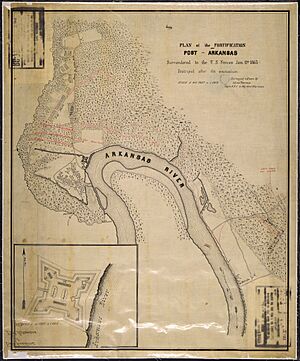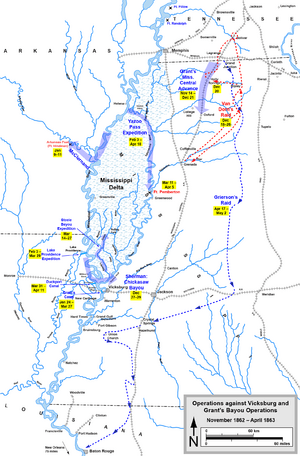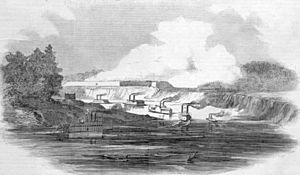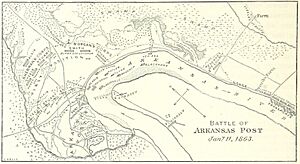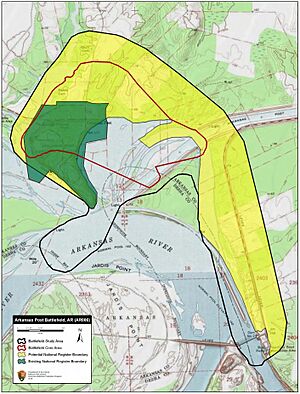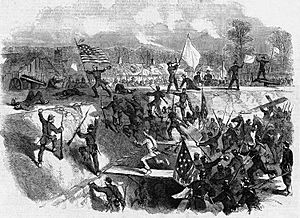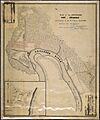Battle of Arkansas Post (1863) facts for kids
Quick facts for kids Battle of Arkansas Post |
|||||||
|---|---|---|---|---|---|---|---|
| Part of the Vicksburg Campaign of the American Civil War |
|||||||
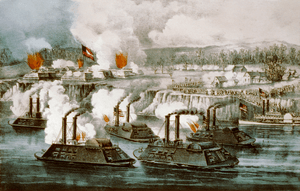 The Bombardment and Capture of Fort Hindman, Arkansas Post, Ark. Jany. 11th 1863 by Currier & Ives |
|||||||
|
|||||||
| Belligerents | |||||||
| Commanders and leaders | |||||||
| Units involved | |||||||
| Garrison of Fort Hindman | |||||||
| Strength | |||||||
| ~30,000 | ~5,000 | ||||||
| Casualties and losses | |||||||
| 1,092 | c. 5,000 | ||||||
The Battle of Arkansas Post, also called the Battle of Fort Hindman, was a fight during the American Civil War. It happened from January 9 to 11, 1863, near the Arkansas River in Arkansas. This battle was part of the larger Vicksburg Campaign, which was a major effort by the Union to control the Mississippi River.
Confederate soldiers had built a strong fort called Fort Hindman near Arkansas Post in late 1862. In December, a Union army led by Major-General William T. Sherman went on a mission to capture Vicksburg. However, Sherman's attack at Chickasaw Bayou failed. After this, Major-General John A. McClernand arrived and took command of the Union forces in January 1863.
McClernand then decided to attack Arkansas Post, even though General Ulysses S. Grant didn't approve. Union soldiers arrived near the fort on January 9 and moved into position on January 10. That evening, Union warships heavily bombed the Confederate fort. On January 11, McClernand ordered his soldiers to attack. They moved close to the fort. After facing heavy artillery fire, Confederate soldiers began to show white flags, signaling surrender, around 4 or 4:30 p.m. The Confederate commander, Brigadier-General Thomas J. Churchill, said he didn't order the surrender, but it happened anyway. Grant later understood the importance of capturing Arkansas Post, but he still changed McClernand's command.
Contents
Why the Battle Happened
Building Fort Hindman
In September 1862, the Confederates wanted to protect the Arkansas River and White River in Arkansas. Colonel John W. Dunnington was put in charge of these defenses. He chose a spot for a fort on the Arkansas River, very close to the small town of Arkansas Post.
The fort was built about 0.25 miles (0.4 km) north of the village. It was placed on a sharp bend in the river, which gave it a good view to control river traffic. The fort had three large cannons and eight smaller ones. The large cannons were originally from a Confederate ship called the CSS Pontchartrain. The fort was square-shaped, with each side about 100 yards (91 m) long. Inside, there were three buildings, two places to store gunpowder, and a well. Trenches were dug from the fort about 720 yards (660 m) west to a place called Post Bayou. On December 10, Brigadier-General Thomas J. Churchill was given command of this important fort.
Union Plans for Vicksburg
Meanwhile, in Mississippi, Union General Grant was trying to capture Vicksburg, Mississippi. This city was very important because it controlled a large part of the Mississippi River. Grant started his attack on Vicksburg on November 26 with 40,000 soldiers.
In December, General Henry Halleck suggested a naval attack down the Mississippi River against Vicksburg. Major-General McClernand had been planning a river attack since November and thought he would lead it. However, Halleck did not trust McClernand. He made sure McClernand's orders said he could only use troops that Grant didn't need. Grant, who also had problems with McClernand, chose Sherman to lead the river attack instead.
After Sherman reached Memphis to get ready, Halleck told Grant that President Abraham Lincoln wanted McClernand to lead the naval mission. Grant knew Sherman was about to start, so he sent McClernand a letter (not a faster telegram) offering him a position under his command.
Sherman's First Attack
Acting Rear-Admiral David D. Porter was in charge of the Union Navy ships for the Vicksburg mission. Sherman's soldiers left Memphis on December 20. McClernand was still in Illinois, so the mission he wanted to lead left without him.
On the same day Sherman left, Confederate cavalry raids destroyed Grant's supply lines, forcing Grant to retreat. Sherman's force, with over 30,000 men, reached the Vicksburg area on Christmas Eve. They sailed up the Yazoo River. After landing on December 26 and 27, the Union soldiers attacked Confederate defenses at Chickasaw Bayou on December 29. But they were pushed back with many losses. Defeated, Sherman's men got back on their ships on January 1, 1863, and left the area.
Getting Ready for Battle
McClernand Takes Command
When Sherman returned to the Mississippi River from the Yazoo, he met McClernand. McClernand was unhappy about not leading the river mission. After they talked, McClernand took command of the force, calling it the Army of the Mississippi. Sherman became one of his commanders. Sherman did not like McClernand being in charge.
In late December, Confederate troops captured a Union supply ship, the Blue Wing, and sent it to Arkansas Post. Sherman heard about this and thought more raids from Arkansas Post were likely. He saw Arkansas Post as a threat and believed a victory there would help his soldiers feel better after their defeat at Chickasaw Bayou. So, Sherman started planning an attack on the fort.
McClernand had also decided to attack Arkansas Post. On the night of January 3/4, both officers talked to Admiral Porter about using his navy ships for the attack. Porter didn't like McClernand, but he agreed to help for Sherman's sake.
Union Army Organization
McClernand believed he was in charge of a whole army, but he was actually only a corps commander under Grant. On January 4, McClernand organized his forces into two corps: the 13th and 15th Army Corps. Sherman commanded the 15th Corps. The 13th Corps was led by Brigadier-General George W. Morgan.
The 13th Corps had two divisions, led by Brigadier-Generals Andrew J. Smith and Peter J. Osterhaus. The 15th Corps also had two divisions, commanded by Brigadier-Generals Frederick Steele and David Stuart.
Confederate Defenders
At Arkansas Post, General Churchill had about 5,000 Confederate soldiers. Most of these men were cavalry (soldiers on horseback) from Arkansas and Texas, but they were fighting on foot. Only about 3,000 of them were healthy enough to fight because many were sick. Most of them had short-range carbines and shotguns, not longer-range rifles. Churchill's command was split into three brigades, led by Colonels Dunnington, Robert Garland, and James Deshler.
The Battle Begins
January 9 and 10: Union Advance
McClernand's force, which included about 30,000 infantry (foot soldiers), 1,000 cavalry, and 40 cannons, started moving up the river on January 5. To keep their attack a surprise, the Union fleet first went into the White River. Then, they used a connecting channel to get back into the Arkansas River. The soldiers traveled on transport ships, with nine warships supporting them. Three of these warships were ironclad ships, meaning they were covered in metal for protection: the USS Baron DeKalb, USS Louisville, and USS Cincinnati.
On January 9, General Churchill learned that the Union fleet was coming. He ordered his men to defend an outer line of trenches that were not yet finished. A group of Texans was sent forward to scout, and six cannons were moved to the rifle pits near the river. Meanwhile, McClernand's men began getting off their ships about 3 or 4 miles (5 or 6 km) from Arkansas Post, starting at 5 p.m. Morgan's corps was to attack directly, while Sherman's corps was to go around and attack from the northwest. That same day, the Union warships began firing at the Confederate defenses.
On the morning of January 10, Sherman's men finished unloading around 11 a.m. One of Morgan's brigades crossed the river to stop any Confederate reinforcements from coming by water. As Sherman started his flanking move, McClernand changed the plan for Stuart's division, sending them on a more direct path. Steele's men found their flanking path blocked by a swamp and had to turn back.
Admiral Porter's ships were also busy. The ironclads and the gunboat USS Lexington fired at Fort Hindman. Other gunboats, the USS Black Hawk and USS Rattler, fired at the rifle pits.
Around 2 p.m., Churchill learned of Sherman's flanking move and pulled his soldiers back from the outer line. Stuart's men quickly took over this line. Morgan's men also advanced, and the Union lines spread out. Stuart's men were on the right, near Post Bayou, and Smith's men were on the left. There were some delays as the Union troops moved into these positions.
McClernand had told Porter that his men would be ready to attack at 2 p.m. At 5:30 p.m., McClernand finally said his men were ready, and the Union ships moved closer to the fort to bomb it. The three ironclads got very close, each focusing on one of the heavy Confederate cannons. Lexington and Black Hawk also fired to help. The naval attack was very effective, killing most of the horses inside the fort. The Rattler tried to go past the fort to fire from behind, but it was damaged and had to leave. The Confederate cannons stopped firing. However, McClernand did not attack, and it soon got too dark. Even though the fort was badly damaged, Union ships also took hits. The Rattler was badly damaged, 17 men were hurt on the Baron DeKalb, the Cincinnati was hit 9 times, and the Louisville was hit 5 times.
Churchill was told by Lieutenant-General Theophilus Holmes to "hold out till help arrived or all dead." Holmes first said no to sending more soldiers, but then said he would. A company of Texans reached the Confederate position on the night of January 10. McClernand also moved his troops at night. There was a gap between Stuart's division and Post Bayou, so Steele's men were brought up to fill it.
January 11: The Final Attack
On the morning of January 11, the Confederates finished improving their defenses. Deshler's left side was open, so he moved the 15th Texas Cavalry to make the line stronger. Also that morning, Steele ordered Brigadier-General Charles E. Hovey's brigade to move towards the Arkansas River to surround the Confederate forces. To stop this, Deshler pulled men from his units to form a skirmish line to defend the area. Hovey's and Deshler's men started fighting. When Churchill learned of Hovey's move, he sent more Texans and two companies of Louisiana cavalry to defend the line. He also sent the 19th Arkansas Infantry and four cannons to help Deshler. Around noon, another of Steele's brigades, led by Brigadier-General John M. Thayer, moved to Hovey's left.
That morning, Sherman also ordered Stuart to move a brigade forward towards the fort. Stuart sent Colonel Giles A. Smith's brigade forward in two lines, supported by Colonel Thomas Smith's brigade. Andrew Jackson Smith's division also moved forward. Two large 20-pounder cannons were brought up to fire at one of the 9-inch Confederate cannons in the fort, which had caused problems for Porter's ships the day before. At 1 p.m., Porter's ships moved towards the fort to bomb it again.
The three Union ironclads, with help from the Lexington and two other gunboats, fired from the river. Union cannons on land also joined in. Four cannons from the Chicago Mercantile Battery also fired. It took only about an hour to destroy one side of the Confederate fort and knock out all three heavy cannons.
The Union land artillery was ordered to fire for thirty minutes. After that, the infantry attack would begin three minutes later. When the infantry attacked, they were told to yell loudly. This way, the naval ships would hear them and know to stop firing at the fort to avoid hitting their own soldiers. Sherman stopped his cannon fire early and sent his soldiers to attack.
When Hovey's brigade attacked, they faced fire from Confederates across Post Bayou. The 17th Missouri Infantry lined up along Post Bayou to counter this. Fire from Deshler's Confederates and two of Hart's cannons stopped the Union attack until the 76th Ohio Infantry moved up and drove the Confederate cannon crews away. Hovey was wounded in the arm but kept fighting. To the left, Thayer's brigade was pushed back by the 10th Texas Infantry. Hovey then had the 3d Missouri Infantry and the 31st Iowa Infantry attack the 15th Texas Cavalry, but they were also pushed back. Deshler sent the 19th Arkansas to help the Texans.
In Stuart's area, Giles Smith's brigade came under heavy fire from Hart's battery. Soldiers had to crawl forward to a wooded spot to fire at the battery and silence it. T. K. Smith's brigade lined up next to Giles Smith's, and two artillery batteries were brought forward. These two brigades then waited for a general attack on the Confederate defenses. To fight back, Deshler asked for more soldiers and received parts of three Texas cavalry units.
As the Union attack moved from right to left, Brigadier-General Stephen G. Burbridge's brigade from Morgan's corps advanced. Confederate soldiers fired at them from a group of huts, but the 23d Wisconsin Infantry cleared them out. The brigade was forced to stop by fire from Garland's brigade when it got close to the Confederate position. Colonel William Landram's brigade was brought up to help. These two brigades fought Garland's men for an hour and a half. Burbridge's group suffered about a third of all Union casualties in the battle. At 3 p.m., Osterhaus sent his only available brigade into the fight, and the Confederate defenders were pushed back. The 120th Ohio Infantry tried to storm the fort but got stuck in a ravine under Confederate fire.
The Union began a heavy artillery attack, planning a big advance once it was over. Porter sent the Rattler, the gunboat USS Glide, and the ram USS Monarch past the fort to fire into it from behind. Around 4 or 4:30 p.m., white flags of surrender began to appear over Fort Hindman.
Garland heard that Churchill had ordered the surrender, though the orders didn't come through the usual ways. Historian Ed Bearss believes Churchill did not actually give the order. Churchill himself also said he didn't order it. Seeing the white flags, Sherman told Steele to stop fighting and went to the Confederate position. He ordered Garland to have his brigade put down their weapons. Andrew Jackson Smith had Burbridge advance to the fort. Burbridge went to personally put a flag on the fort, but Confederate soldiers said the fort had not surrendered until the white flags were pointed out to them. Deshler did not believe a surrender had happened and kept fighting until Union troops called for a flag of truce. During the truce, Deshler told Steele he intended to keep fighting. Steele told Sherman, who sent Churchill to talk with Deshler. Eventually, Deshler agreed to surrender after Sherman explained that his line was surrounded by Union soldiers and some of his men had already been disarmed.
What Happened Next
When the surrender was complete, 4,791 Confederate soldiers had been captured. Records show that about 60 more Confederates were killed and 80 wounded. In total, Confederate losses were around 5,004. McClernand reported capturing 17 cannons, 3,000 infantry weapons, and other equipment. The soldiers lost at Arkansas Post made up about one-third or one-fourth of all Confederates in Arkansas at that time. A few hundred men managed to escape back to General Holmes. Union losses were 1,092 men. McClernand's force had 1,061 casualties, and Porter's navy had 31.
"Glorious! Glorious! My star is ever in the ascendant."
General Grant had originally thought the expedition to Arkansas Post was a waste of time. He had ordered McClernand to return to the Vicksburg area as soon as he found out about the Arkansas Post movement. Grant later sent a disapproving letter to Halleck, who then gave Grant permission to change McClernand's command. McClernand made plans to attack Little Rock, but Grant overruled this. Grant came down the Mississippi River to take overall command of the army. Porter and Sherman were able to convince Grant that the Arkansas Post expedition was actually valuable. Grant later noted that the Confederate force at Arkansas Post could have caused problems if it had been left alone. On January 18 or 19, the Army of the Mississippi was broken up, and McClernand became a corps commander under Grant. Part of the battlefield is now within Arkansas Post, but about 360 acres (146 ha) have been covered by water due to changes in the river and the building of the Arkansas Post Canal.
Images for kids


